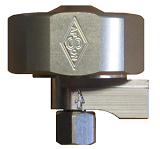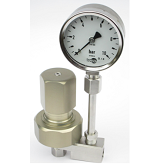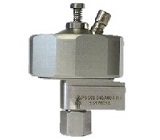
Pressure Regulators
Overview
In addition to pneumatically controllable paint pressure regulators for automated painting applications, APSON also supplies manually adjustable paint pressure regulators (equipped with pressure gauges) for conventional painting applications. The regulators
are robust, regulate fast, have high throughput, are easy to flush, and are particularly suitable for liquid aggressive work materials, e.g. plain and metallic paints, solvents and alkalis.
Selection help (see also >>>
Application Info)
For the use of paint pressure regulators, only 1 atomizer resp. consumer per 1 regulator must be provided!
For the use of paint pressure regulators, only 1 atomizer resp. consumer per 1 regulator must be provided!
| Regulator image | Regulator type * |
Input pressure [bar] |
Output pressure, approx. [bar] |
Membranes, W / F ** |
Outlets & plane resp. direction *** |
|---|---|---|---|---|---|

|
PRP-2001, pneumatically controllable | max. 20 | 1-20 | 2, F or W |
Horizontal or 45° downwards |

|
PRM-2007, manually adjustable | max. 20 | 1-16 | 1, F or W |
1 horizontal, 1 vertical |

|
PRP-2023-R, pneu. ctrl., forwards and backwards rinseable | max. 20 | 1-20 | 2, F or W |
Horizontal |
|
|
PRP-3001-PF, mini-regulator, pneu. ctrl., quickly replaceable | max. 10 | 1-10 | 2, F or W |
Horizontal, each 40° left resp. right |

|
PRx-3030-K, pneu. ctrl. resp. man. adj., cartrige quickly replaceable | max. 20 | 1-20 (P); 1-16 (M) |
2, F or W |
45° downwards (P); 1 horiz., 1 vert. (M) |
* Pneumatic Pressure Regulators from APSON are standardly equiped with two Membranes. This provides greater safety in case of a defect (normaly no intrusion of fluid work material into the pneumatics), resp. easy failure diagnose.
** W=waved membrane, F=flat membrane. Lacquer pressure regulators with waved membranes usually regulate pressure jumps faster and more accurately, due to the smaller hysteresis of waved membranes. Paint pressure regulators with flat membrane are usually a little faster flushable.
*** The vertical outlet of the lacquer pressure regulator is designed for a - possibly throttled and / or glycerine-damped - pressure gauge with riser tube.
Paint pressure regulators with special features according to customer specifications are available on request.
Minimizing the wear of membranes: Painting applications should be run with the lowest possible pressure. This may require larger nozzles or outlets on the atomizer or consumer.
Diaphragms of pneumatically controllable regulators suffer less stress at each output pressure than diaphragms of mechanically adjustable regulators, and can handle higher output pressures because on the one side there is applied material pressure and on the other side is applied pneumatic control pressure, to the entire area. There is always pressure equalization and, as a result, force compensation.
Diaphragms of mechanically adjustable regulators suffer more stress at each output pressure than diaphragms of pneumatically controllable regulators, and tend to bulge at high output pressures because on opposte side of the working material – besides the force of the compression spring – always prevails only the atmospheric pressure. Ergo there is force compensation but no pressure equalization. Therefore, APSON recommends for mechanically adjustable regulators with standard diaphragms smaller outlet pressures (see table above)!
The wear of membranes is highly dependent on the application. To determine the appropriate intervals for replacing membranes, the membranes should initially be checked for as many times to maximum tolerable wear or maximum tolerable buckling.
On request, APSON also supplies paint pressure regulators with properties according to the specifications of the customer.
** W=waved membrane, F=flat membrane. Lacquer pressure regulators with waved membranes usually regulate pressure jumps faster and more accurately, due to the smaller hysteresis of waved membranes. Paint pressure regulators with flat membrane are usually a little faster flushable.
*** The vertical outlet of the lacquer pressure regulator is designed for a - possibly throttled and / or glycerine-damped - pressure gauge with riser tube.
Paint pressure regulators with special features according to customer specifications are available on request.
Minimizing the wear of membranes: Painting applications should be run with the lowest possible pressure. This may require larger nozzles or outlets on the atomizer or consumer.
Diaphragms of pneumatically controllable regulators suffer less stress at each output pressure than diaphragms of mechanically adjustable regulators, and can handle higher output pressures because on the one side there is applied material pressure and on the other side is applied pneumatic control pressure, to the entire area. There is always pressure equalization and, as a result, force compensation.
Diaphragms of mechanically adjustable regulators suffer more stress at each output pressure than diaphragms of pneumatically controllable regulators, and tend to bulge at high output pressures because on opposte side of the working material – besides the force of the compression spring – always prevails only the atmospheric pressure. Ergo there is force compensation but no pressure equalization. Therefore, APSON recommends for mechanically adjustable regulators with standard diaphragms smaller outlet pressures (see table above)!
The wear of membranes is highly dependent on the application. To determine the appropriate intervals for replacing membranes, the membranes should initially be checked for as many times to maximum tolerable wear or maximum tolerable buckling.
On request, APSON also supplies paint pressure regulators with properties according to the specifications of the customer.

